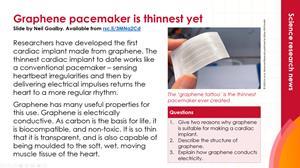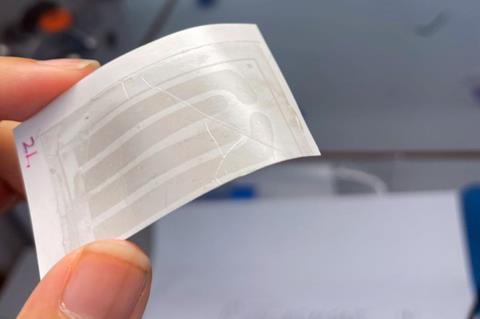Next generation electrodes for treating arrhythmias could be comprised of carbon allotrope
-

Download this
Use this story and the accompanying summary slide for a real-world context when studying carbon allotropes and graphene with your 14–16 learners.
Download the story as MS Word or PDF and the summary slide as MS PowerPoint or PDF.
US researchers have developed the first cardiac implant electrodes made from graphene. These ‘graphene tattoos’ visually resemble temporary tattoos for children, and experiments on rats have shown they outperform conventional pacemaker electrodes.
Abnormal heart rhythms, known as arrhythmias, are one of the leading causes of death worldwide. They are often treated with devices such as pacemakers, comprised of electrodes attached to the heart that are connected via wires to an electronics box implanted in the chest. These devices sense the electrical activity of the heart and, when irregular heart rhythms are spotted, restore a normal heartbeat by delivering electrical stimulation.

Flex for success
Pacemaker electrodes are currently made of hard metal and other rigid materials that are not ideal for attaching to the soft, wet, dynamic muscle tissue of the heart. Graphene consists of a single layer of carbon atoms and is flexible enough to be moulded to fit perfectly to a heart. It is also stretchy and strong enough to withstand the motions of a beating heart.
The team led by Igor Efimov, a professor at Northwestern University in Illinois, US, has demonstrated the effectiveness of its graphene tattoos on rats. In these experiments, the scientists attached the electrodes to the rat hearts and the electronics box using foil rather than wires.
The end goal is to send electric pulses wirelessly between the electrodes and the electronics box. This would eliminate the need to implant the box, replacing it with an external device placed on the chest instead. As a significant step towards this goal, the scientists demonstrated that they could collect electrical information from the graphene tattoo and stimulate the heart using a blue light source outside the body.
Igor told Chemistry World that before such a device can enter human trials, scientists will need to prove its safety and efficacy in large animal models such as pigs.
Put this in context
New inventions need legal protection and it’s the job of a patent attorney to help the inventors get their products into the market.
This article is adapted from Rebecca Trager’s in Chemistry World.
Nina Notman
Reference
Z Lin et al, Adv. Mater., 2023, DOI: 10.1002/adma.202212190
Download this
Summary slide with questions and the article for context when teaching your 14–16 classes on types of carbon: rsc.li/3OKkmgN
Graphene is flexible enough to be moulded to fit perfectly to a heart
Downloads
EiC summary slide graphene pace maker
Presentation | PDF, Size 0.18 mbEiC summary slide graphene pace maker
Presentation | PowerPoint, Size 0.31 mbEiC science research story Graphene pace maker
Handout | PDF, Size 0.19 mbEiC science research story Graphene pace maker
Handout | Word, Size 0.79 mb















No comments yet